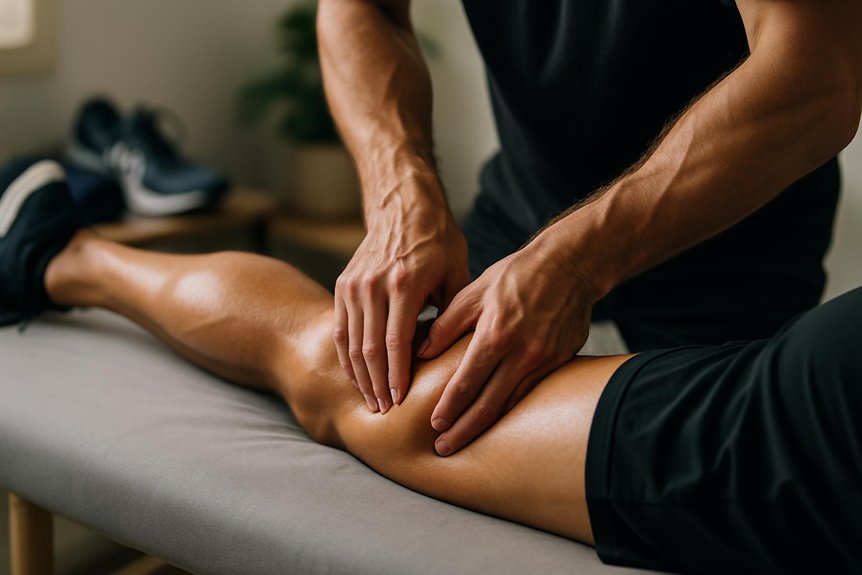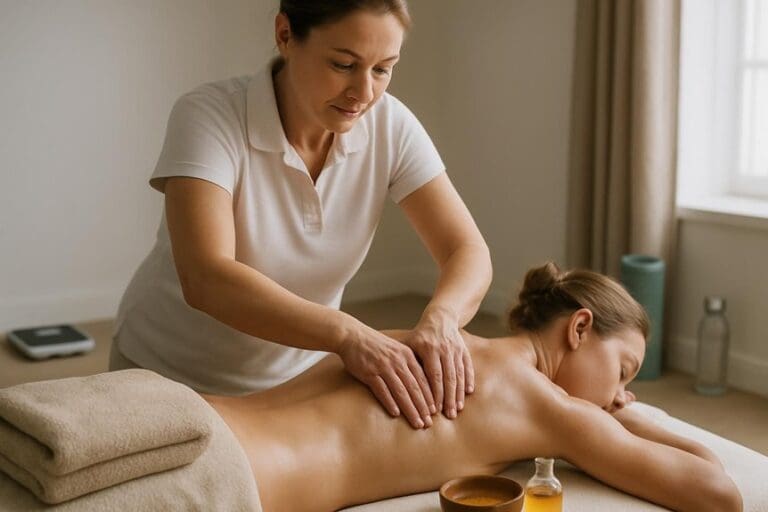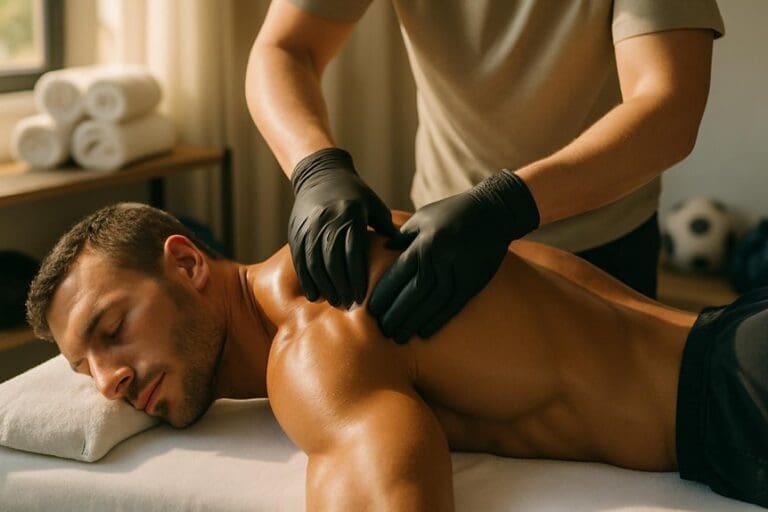This therapy is a clinical intervention using targeted manual techniques to address the specific musculoskeletal demands of athletic activity. It employs deep tissue manipulation, trigger point therapy, and stretching to optimize tissue pliability, circulation, and recovery. Designed for injury prevention and enhanced performance, it differs from relaxation massage by focusing on function and rehabilitation. Sessions are tailored to individual needs, providing effective treatment for various athletic conditions. Further on, detailed principles and practical expectations are outlined.
Understanding the Principles
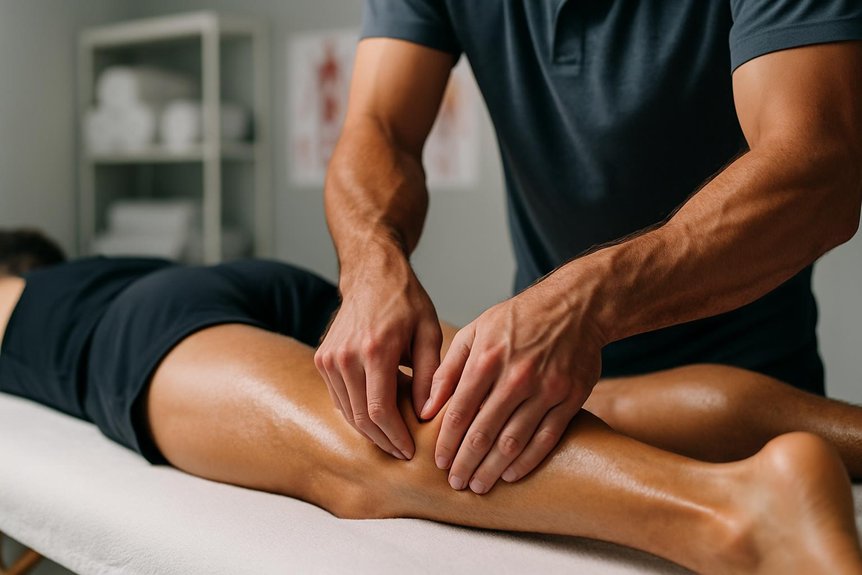
How does it differentiate itself within the spectrum of manual therapies? Sports massage is defined by its targeted focus on the unique physiological demands of athletic activity. It addresses both acute and chronic musculoskeletal tension, optimising tissue pliability, circulation, and recovery.
Unlike general relaxation massage, this integrates assessment and treatment protocols tailored to the client’s activity profile, training cycle, and performance goals. At Spa & Massage clinics, therapists employ evidence-based methodologies to support injury prevention, accelerate post-exercise recovery, and facilitate functional mobility.
Emphasis is placed on understanding tissue integrity, neuromuscular function, and biomechanical imbalances. This approach fosters a therapeutic alliance, where the client’s needs are continuously evaluated and addressed, ensuring interventions remain responsive and highly individualised throughout each session and across the athletic lifespan. In contrast, Deep Tissue Massage is known for its focus on targeting deeper layers of muscle and connective tissue to alleviate chronic tension and improve overall muscular health.
Key Techniques Used in this Therapy
This therapy incorporates a range of specialised manual techniques, including deep tissue manipulation, trigger point therapy, and targeted stretching and mobilisation.
These methods are employed by Spa & Massage therapists to address musculoskeletal dysfunction, optimise tissue recovery, and enhance range of motion.
Each approach is selected and adapted to meet the specific therapeutic goals and physical needs of the individual client.
Deep Tissue Manipulation
Within the clinical framework of this therapy, deep tissue manipulation serves as a cornerstone technique for addressing musculoskeletal dysfunctions and promoting ideal athletic performance. This method involves the application of sustained, targeted pressure and slow strokes to access deeper layers of muscle fascia and connective tissue.
By focusing on areas of chronic tension and adhesions, therapists at Spa & Massage aim to facilitate increased circulation, improved tissue elasticity, and accelerated recovery. The technique is especially beneficial for clients experiencing restricted range of motion or post-exertional muscle soreness.
At Spa & Massage clinics, therapists combine expert anatomical knowledge with sensitive palpation, ensuring that each session is both effective and attuned to individual comfort levels. Proper aftercare and hydration are always recommended to support excellent outcomes.
Trigger Point Therapy
Precisely targeted manual pressure distinguishes trigger point therapy as an essential modality, designed to deactivate hyperirritable nodules within taut bands of skeletal muscle.
At Spa & Massage, therapists employ focused compression techniques, meticulously locating and addressing these myofascial trigger points to reduce referred pain, restore muscle flexibility, and enhance overall neuromuscular function.
This approach demands anatomical expertise and sensitive palpation, allowing practitioners to interpret tissue response and tailor pressure accordingly.
Clients often experience both localized and referred sensations during application, a normal response as ischemic pressure disrupts the pain-spasm-pain cycle.
Trigger point therapy is particularly valued by athletes and active individuals seeking relief from chronic muscular tension, postural imbalances, or acute sports injuries, supporting faster recovery and improved performance outcomes.
Stretching and Mobilisation
Beyond targeted trigger point therapy, effective technique incorporates advanced stretching and mobilisation techniques to optimize musculoskeletal function. These techniques increase soft tissue flexibility, promote joint range of motion, and assist in restoring optimal biomechanics.
In practice, therapists at Spa & Massage employ both passive and active stretching modalities, as well as joint mobilisation procedures tailored to individual anatomical needs. Stretching reduces myofascial tension and enhances neuromuscular efficiency, while mobilisation addresses joint restrictions and supports functional movement patterns.
Therapists assess tissue response in real time, adjusting interventions to promote comfort and sustainable progress. This clinical approach not only benefits athletes managing specific injuries but also supports those seeking to maintain supple, resilient musculature.
Clients are often provided with stretching guidance for ongoing self-care between sessions.
How This Massage Differs From Other Massage Types
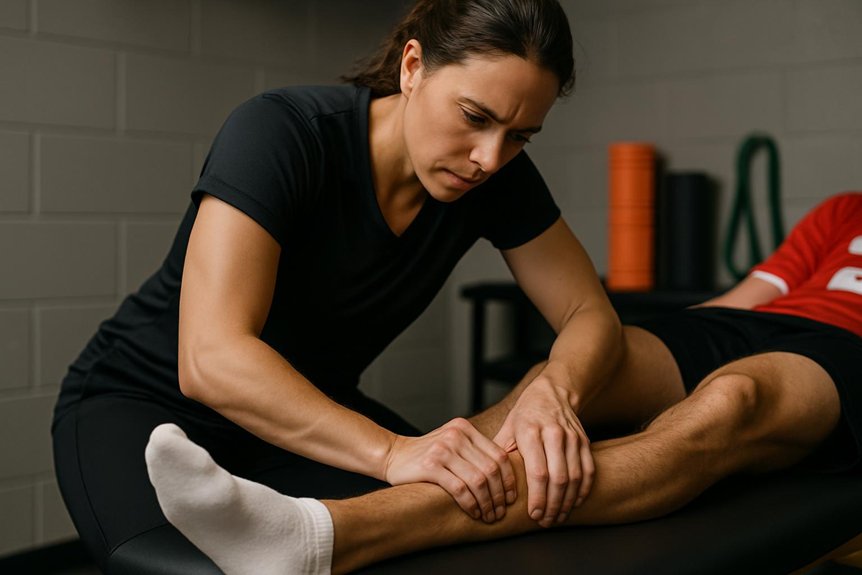
This therapy is distinguished from other massage types by its targeted approach to addressing musculoskeletal issues related to physical activity. Unlike relaxation-focused techniques such as Swedish or aromatherapy massage, it employs specific manipulations—deep tissue work, trigger point therapy, and myofascial release—tailored to the unique demands placed on the body by exercise and repetitive motion.
The aim is to enhance tissue recovery, improve flexibility, and reduce the risk of injury. At Spa & Massage, therapists adapt each treatment to the client’s athletic history and movement patterns, utilising clinical assessment skills to identify areas of tension or dysfunction.
The focus remains on restoring ideal function and supporting ongoing physical performance, rather than solely promoting general relaxation or stress relief.
Common Conditions Addressed
Numerous musculoskeletal conditions frequently benefit from targeted therapeutic intervention, particularly those resulting from athletic activity or repetitive movement patterns. Conditions such as delayed onset muscle soreness (DOMS), muscle strains, ligament sprains, and myofascial trigger points are commonly addressed through these techniques.
It is also often indicated for tendinopathies, chronic muscle tightness, and overuse injuries associated with specific sports or occupational demands.
At Spa & Massage, therapists utilize clinical assessment to identify tissue dysfunction, applying modalities such as deep tissue manipulation, friction techniques, and neuromuscular therapy.
This precise approach assists in reducing adhesions, alleviating localized tension, and supporting ideal tissue recovery.
Clients experiencing restricted range of motion, localized pain, or postural imbalance frequently seek this therapy as part of an integrative musculoskeletal care strategy.
Benefits for Athletes and Active Individuals
This therapy provides measurable benefits for athletes and active individuals, including accelerated muscle recovery, targeted injury prevention strategies, and enhanced athletic performance.
By employing evidence-based manual techniques, therapists can address muscular imbalances, reduce soft tissue restrictions, and promote ideal tissue function.
At Spa & Massage clinics, tailored treatment protocols are integrated to support these specific outcomes and meet the demands of physically active clients.
Enhanced Muscle Recovery
How does targeted manual therapy facilitate ideal muscle recovery in athletes and active individuals? As practiced at Spa & Massage, employs specialised techniques such as effleurage, petrissage, and myofascial release to accelerate the removal of metabolic waste, enhance local circulation, and reduce delayed onset muscle soreness (DOMS).
These interventions support cellular repair by increasing oxygen and nutrient delivery to soft tissues, while simultaneously modulating neuromuscular tone to alleviate tension. Therapists at Spa & Massage tailor each session to optimise post-exertion recovery, enabling clients to return to training sooner and with improved muscle pliability.
Injury Prevention Strategies
While physical training intensity and repetition place considerable demands on soft tissues, the implementation of proactive injury prevention strategies remains essential for athletes and active individuals.
This therapy serves as a critical intervention by identifying and addressing areas of muscular tension, fascial restriction, or biomechanical imbalance before they escalate into injuries. At Spa & Massage, therapists utilise targeted techniques such as myofascial release, deep tissue manipulation, and stretching protocols to promote *ideal* tissue pliability and joint mobility.
Regular sessions not only facilitate early detection of microtrauma but also enhance proprioceptive awareness, allowing individuals to adjust movement patterns that may predispose them to injury. This integrative approach fosters resilience in musculoskeletal structures, supporting clients’ ongoing participation in demanding physical activities with reduced risk of strain or overuse.
Improved Athletic Performance
Beyond reducing injury risk, targeted massage therapy confers measurable advantages to athletic performance. It enhances circulation, facilitating more efficient delivery of oxygen and nutrients to working muscles while promoting metabolic waste removal. This process optimizes muscle recovery and may expedite tissue repair following strenuous activity.
Additionally, specific techniques—such as those employed at Spa & Massage clinics—address muscular adhesions and imbalances, fostering improved range of motion and neuromuscular coordination. These effects contribute to increased power output, flexibility, and sustained endurance during athletic pursuits.
For many clients, regular sessions provide not only physical restoration, but also psychological benefits, including reduced performance anxiety and heightened mental clarity. In the context of both training and competition, this offers a strategic advantage for those seeking peak physical condition.
What to Expect During Its Session
During a session at Spa & Massage, clients undergo a targeted assessment and treatment process designed to address specific musculoskeletal concerns. The therapist begins with a consultation to identify areas of tension, injury history, and individual goals.
Next, the client is positioned for ideal comfort and privacy, while the practitioner applies precise techniques such as effleurage, petrissage, friction, and myofascial release.
Focus is directed to muscle groups requiring therapeutic intervention, guided by palpation and feedback. Techniques are often adjusted in real time to accommodate tissue response and client sensitivity.
At Spa & Massage, high-quality oils are selected to enhance glide and tactile connection, fostering a sense of security and trust throughout the session.
Each treatment is tailored for maximum therapeutic benefit.
Aftercare Recommendations From Our Therapists
How can ideal recovery and sustained benefits be guaranteed following a therapy? At Spa & Massage, therapists advise tailored aftercare to optimise tissue repair, reduce post-treatment discomfort, and prolong therapeutic effects.
Immediate hydration is vital, facilitating metabolic waste elimination mobilised during session. Gentle stretching maintains muscle pliability and prevents stiffness.
Clients are encouraged to avoid intensive physical exertion for 24 hours, allowing muscular microtrauma to resolve. Application of cold or heat as directed can modulate inflammation or soothe residual tension.
Therapists may recommend specific home exercises to reinforce neuromuscular adaptation. Attentiveness to bodily sensations—such as delayed-onset soreness or fatigue—enables timely self-care adjustments.
These evidence-based guidelines, combined with the expertise of Spa & Massage professionals, foster a restorative, lasting transformation.
How Often Should You Book a Session?
An individual’s ideal frequency for having this therapy depends on variables such as training intensity, athletic goals, injury history, and recovery needs. At Spa & Massage, therapists perform an initial assessment to identify biomechanical imbalances and areas of chronic tension, then recommend an appropriate schedule.
For active individuals in consistent training, every 1–2 weeks may maximise muscle recovery and support injury prevention. Those recovering from injury or managing high physical stress might benefit from more frequent sessions, as clinically indicated.
Conversely, individuals seeking maintenance or general wellbeing may find monthly appointments sufficient. Regular evaluation of progress ensures that treatment frequency remains aligned with evolving needs.
Personalised scheduling fosters perfect outcomes and cultivates a deeper connection between body awareness and holistic wellbeing.
Choosing the Right Massage Therapist
Selecting an appropriate therapist directly influences treatment outcomes and overall musculoskeletal health. Clinical expertise, anatomical knowledge, and proficiency in advanced manual techniques are essential qualifications.
At Spa & Massage, therapists undergo rigorous training and continuous professional development to guarantee evidence-based, individualized care. Clients are encouraged to seek practitioners who understand both acute and chronic sports-related conditions and who communicate effectively regarding goals, progress, and aftercare strategies.
A therapist’s ability to establish trust and rapport enhances therapeutic efficacy, supporting clients in achieving both physical restoration and psychological well-being. Consistency in practitioner-client interaction fosters a safe environment for sharing concerns and tailoring treatment plans.
Spa & Massage prioritizes a holistic approach, integrating technical skill with compassionate presence, to promote ideal recovery and long-term athletic performance.
Conclusion
In the quiet aftermath of a session, muscles release tension like ripples settling on a still lake, fibres realign, and circulation flows with renewed vigour. This clinically grounded therapy, tailored to the biomechanical demands of active bodies, not only mitigates injury risk but also accelerates physiological recovery. For athletes and fitness enthusiasts alike, this stands as an indispensable modality—precision-guided, evidence-based, and expertly delivered to optimise musculoskeletal health and functional performance.
